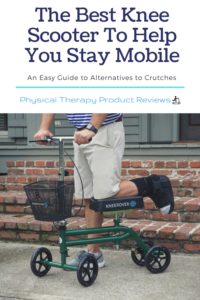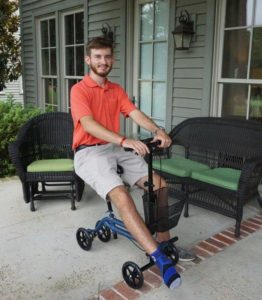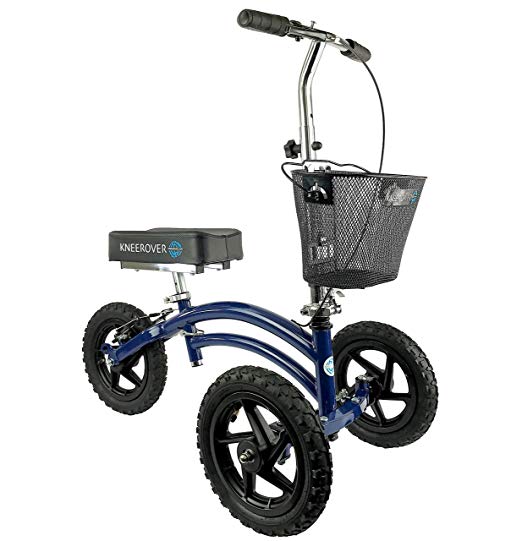A knee scooter is an excellent option for mobility after an injury. Especially, for anyone that is going to be on crutches for longer that a week. A knee scooter lets you take pressure off of your arms, let’s you get around the home and work place much faster, and reduces your risk of falling.
| Name | Picture | Price | Best Feature | Our rating | Best Price |
|---|---|---|---|---|---|
| KneeRover All Terrain Steerable Knee Scooter |
 |
$$$ | Best off-road scooter and top choice overall | 9.7/10 | See Current Price |
| Drive Medical Steerable Knee Walker |
 |
$$ | Best 4-wheeled knee scooter | 9.5/10 | See Current Price |
| KneeRover Economy Knee Scooter |
 |
$$ | We love the quick release handlebar, great value for the price | 9.4/10 | See Current Price |
| ELENKER Steerable Knee Walker |
 |
$$ | We love the large basket for working people | 9.4/10 | See Current Price |
| ELENKER Best Value Knee Walker |
 |
$$ | Excellent bang for the buck scooter | 9.2/10 | See Current Price |
What is a Knee Scooter?
A knee scooter is a non-motorized mechanism that has a handlebar for steering, a small resting pad for your knee, and 3-4 wheels for mobility. This allows a person to rest their knee on a single pad and propel themselves with the other foot. The adjustable pad is positioned to allow the right proportions for height and weight distribution while being mobile.
Think of a Knee Scooter as equivalent to steerable crutches!
A knee scooter is an alternative method to crutches where you would normally rest one pad underneath one or both arms to keep weight off of a lower body injury. Instead of relying on your upper body to assist you in moving around, a knee scooter would enable you to use your non-injured leg to provide movement.
Who Would Benefit from a Knee Scooter?
 While crutches are generally used for most lower body injuries, knee scooters benefit those who have calf, ankle, or foot injuries. Scooters are also beneficial to those who do not have a lot of upper body strength. The use of a knee scooter allows a person to have use of their hands while still being able to rest their injured leg on the knee pad.
While crutches are generally used for most lower body injuries, knee scooters benefit those who have calf, ankle, or foot injuries. Scooters are also beneficial to those who do not have a lot of upper body strength. The use of a knee scooter allows a person to have use of their hands while still being able to rest their injured leg on the knee pad.
Some common injuries where a knee scooter is recommended include:
- Ankle, foot, or Knee surgeries where you can’t put weight in the leg
- Any injury with cast on the lower leg
- Foot and Ankle sprains with a walking boot on
- Achilles tendon surgeries or injuries when you can’t place weight on the foot
- Knee scooters are safe to use and help safe the nerves underneath the arm
Recently have a total knee replacement? Check out our reviews on the best recumbent bikes to get you healing faster
Is it Better to Buy or Rent a Scooter?
With as many companies out there willing to sell knee scooters, there are just as many companies that are also willing to rent them. However, the cost of renting can be just as expensive as if you’d purchased one, so it’s important to weigh your options.
Here is a general breakdown of the costs:
Cost To Own: Varies from $100 to $300
Cost to Rent: Averages from $35-50/week, including an initial deposit and risk of wear and tear
Considering these costs, you should next determine how long you will need a unit while you are recovering. If it’s longer than 2 weeks, then it would be more beneficial to you to purchase one. If it’s less, then you should consider renting as it might be more cost effective for you. The good news is that if you need your scooter for longer, there are companies that also have rent to purchase options.
An Insider Tip: Don’t Purchase one from your local hospital unless it will be fully covered by insurance. It will be 2-3x more expensive from your medical professionals.
How to Use a Knee Scooter
FAQ Regarding Knee Scooters
Should I Use Crutches or a Knee Scooter?
It depends! Crutches are great if you only have to use them for a week or less. If you have to be non weight-bearing for longer than that you should consider a knee scooter. Think of it as crutches on wheels. A knee scooter is more comfortable, faster, and better for those that move around frequently at home or work.
Does Insurance Cover a Knee Scooter?
Most of the time insurance will not cover the cost of a knee scooter. Medicare does not cover a knee scooter unless your supplemental insurance will (which is rare). There a few but rare instances that a private insurance company will cover a knee scooter but you will have to call your insurance ask about your specific plan.
Where Can I Donate a Knee Scooter?
Thanks for donating! There are few places that might benefit from your scooter when you are all done with it. Some options include:
- Hospice care
- Local Elks Club, Rotatory, or community center
- Nursing homes
- Local Hospital
Can I Sit on a Knee Scooter?
Sure you can, just be careful sitting on the knee scooter while it’s moving. We actually like to use it at as a seat if we are going to be talking to someone for a while or in a meeting. It does get a bit trickier to propel forward sitting on it while it’s moving.

Can I Use a Knee Scooter with a Cast?
Absolutely, having a cast is one of the best times to use a knee scooter. For comfort reasons, you’ll have to bear weight on your knee instead of cast on the scooter seat.
Traveling with a Knee Scooter
Can You Take a Knee Scooter on an Airplane?
Absolutely! Can you imagine getting though a large airport on crutches? Notify the airline that you will need some assistance first off. They will check your knee scooter at the runway ramp and help you get to your seat in either a wheelchair or with loner crutches. Once you arrive at your destination they will offload the scooter at the runway ramp with strollers and walkers.
Does a Knee Scooter Fold Up?
Unfortunately not really. Most of the knee scooters are made from metal or alloys. You can decrease the overall size of the scooter by lowering and changing the height of the handle but it usually does not fold up like a walker.
The Best Knee Scooters For Better Mobility After an Injury
All Terrain KneeRover Steerable Knee Scooter
Summary: The KneeRover All Terrain Scooter is an indoor/outdoor scooter with 12” inflatable off-road tires that makes traveling across uneven grass, dirt, and pavement a breeze! Even with its heavy duty frame, it only weighs in at 27-lbs which allows for easy transportation and storage.
Pros: This is a scooter that was built for speed and comfort. The 3 wheel design makes it so you don’t hit your good foot when pushing off the ground. The large wheels also enable going over bumps in the pavement and door thresholds less of a challenge.
Cons: Some stability issues if turning sharp corners too quickly or backing up.
Drive Medical Dual Pad Knee Walker with Basket
Summary: As far as comfort goes, the Drive Medical Knee Scooter offers a two-piece knee pad for extra relief during your recovery. It has a set of fully maneuverable front wheels with a dual braking system that allows for greater mobility and safety.
Pros: Thanks to the tool-free adjustment feature, changing the height of the pads and steering wheel is easy and hassle free. It is lightweight, only 22 lbs, which makes it easy to store. Also does very well across smooth surface such as linoleum, concrete, and wood.
Cons: Does not handle as well in grass or dirt.
KneeRover Economy Knee Scooter
Summary: Equipped with 7.5” rubber tires, the KneeRover Economy knee scooter is a great option for indoor spaces. It features dual locking hand brakes and rear on-wheel brakes on a secure dual bar frame for added stability and control.
Pros: Offers an excellent turning radius that is not blocked by the frame during sharp turns.Very affordable for such a quality product. Takes as little as 10 seconds to fold and transport with the easy-to-use thumb release lever.
Cons: The handle bar has the ability to turn 180 degrees which causes a risk in stability.
ELENKER Knee Walker Deluxe Scooter
Summary: Featuring a large vinyl basket and a memory foam knee pad, the Elenker Knee Scooter was designed for your safety and comfort in mind. With a dual braking system, adjustable steering, and fold-able features, you’ll feel in control anytime around the house or when you’re out doing your errands!
Pros: The basket is perfect when going to the grocery store or around the home. The wider wheel base in front adds extra security for balance
Cons: The knee pad is contoured so full cast wearers will have to adjust accordingly.
ELENKER Best Value Medical Scooter
Summary: The ergonomic dual lock braking system and 8” PVC wheels makes the Elenker Medical Scooter a respectable companion for indoor and outdoor use. Lightweight and compact with a nylon basket, traveling to the doctors and moving about the house will be a fun and easy experience!
Pros: The locking brake system is great for when you need to stop or stand still. The extra scoops in the knee pad are perfect if you need to turn to the side.
Cons: This is a tall walker so it is best suited for those who are at least 5’ 6” in height.
In Review
Knee scooters were built with your comfort in mind. They are designed to protect your joints, help you carry items, and make it easier to continue to live life. They are the perfect alternative to crutches when you’re looking at a long recovery time from your injuries!
Works Cited:
Health Pages – https://www.healthpages.org/health-a-z/how-to-use-a-knee-scooter/
Healthable – https://healthable.org/knee-scooters-vs-crutches-for-a-broken-leg-or-foot/
Other Great Rehab Related Articles
How to Stay Active After Cervical Fractures: Expert Tips and Advice
Dealing with Painful Stairs After Ankle Replacement Surgery
Walking After a Total Ankle Replacement: Tips for a Successful Recovery
Exercises While Non-Weight Bearing After Ankle Replacement: Elevation, AROM, Leg Raises, and More
Ankle Pain with Stairs: Causes and Home Treatment Options
5 Common Mistakes You’re Making After an Ankle Sprain
Disclaimer: The information provided in this post is for educational purposes only. This is not a substitute for a medical appointment. Please refer to your physician before starting any exercise program.











